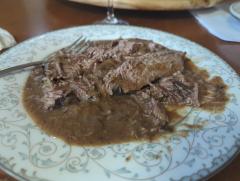 In this classic Italian braised beef recipe, a Cappello del Prete (chuck blade) is cooked very "low and slow" for fall-apart tenderness with great flavor.
In this classic Italian braised beef recipe, a Cappello del Prete (chuck blade) is cooked very "low and slow" for fall-apart tenderness with great flavor.
As with most recipes, having the best equipment makes everything easier. For this one, I wanted to see just how "low-and-slow" I could go, keeping the pot at the lowest heat that would cook the meat. This is because I was cooking a Cappello del Prete, a tough cut from the shoulder with a great seam of connective tissue through the middle of it. Most American supermarkets do not carry this cut, but butchers can do it for you (I got mine from the butcher at Friends Market in Orleans, MA).
Using this cut of meat, I needed the right tool, please see the Notes for more!
Unlike the similar (and costly) Beef Braised in Barolo which is cooked in only wine, this is cooked in 2/3 wine and 1/3 beef stock. This can be served over polenta like the Barolo beef, but it's also good with short pasta or crusty bread.

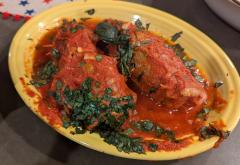 This beef braciole is a fundamental part of a traditional Neapolitan Sunday dinner, simmered slowly in a tomato puree that becomes the sauce for the ziti or rigatoni that always accompanies it. It's loaded with great flavor from long simmering of fine ingredients.
This beef braciole is a fundamental part of a traditional Neapolitan Sunday dinner, simmered slowly in a tomato puree that becomes the sauce for the ziti or rigatoni that always accompanies it. It's loaded with great flavor from long simmering of fine ingredients.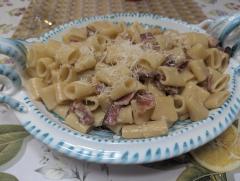 This is my favorite of the
This is my favorite of the 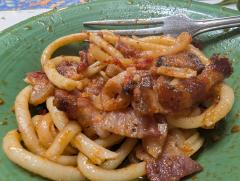 This is one of the four classic Roman pasta dishes, along with
This is one of the four classic Roman pasta dishes, along with 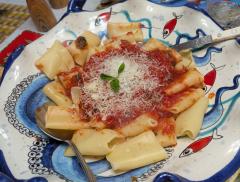 Here's a simple and very classic dish from Naples. There are very few ingredients, so quality is of top importance. I call here for top quality canned tomatoes: that's because the best brands have a reputation to maintain, the tomatoes are ripe when they are canned, so they are far better than "fresh" supermarket tomatoes in January in New England. Of course if you can get farm-fresh tomatoes in August and September, by all means use them! But the rest of the time you will probably be happier with canned tomatoes from an excellent producer. The onion, cheese, and basil must also be of good quality, and that's about all there is to this sauce.
Here's a simple and very classic dish from Naples. There are very few ingredients, so quality is of top importance. I call here for top quality canned tomatoes: that's because the best brands have a reputation to maintain, the tomatoes are ripe when they are canned, so they are far better than "fresh" supermarket tomatoes in January in New England. Of course if you can get farm-fresh tomatoes in August and September, by all means use them! But the rest of the time you will probably be happier with canned tomatoes from an excellent producer. The onion, cheese, and basil must also be of good quality, and that's about all there is to this sauce. This classic from the tiny region of Molise on the Adriatic coast is simple and delicious, but the quality of the ingredients is important. The sauce is just diced guanciale with onion, garlic, basil, and parsley. You need good pancetta or guanciale, and fresh herbs work out better than dried herbs.
This classic from the tiny region of Molise on the Adriatic coast is simple and delicious, but the quality of the ingredients is important. The sauce is just diced guanciale with onion, garlic, basil, and parsley. You need good pancetta or guanciale, and fresh herbs work out better than dried herbs. This version of spaghetti and meatballs comes from Abbruzzo but it is eaten all over Italy. Spaghetti alla Chitarra (say key-TAH-rra) is a long pasta that is traditionally made fresh, then rolled into sheets as thick as uncooked spaghetti and pressed onto a chitarra, a frame with many long closely-spaced parallel wires. The resulting spaghetti is square in cross section. The square chitarra pasta has more surface area than round spaghetti so it holds more sauce.
This version of spaghetti and meatballs comes from Abbruzzo but it is eaten all over Italy. Spaghetti alla Chitarra (say key-TAH-rra) is a long pasta that is traditionally made fresh, then rolled into sheets as thick as uncooked spaghetti and pressed onto a chitarra, a frame with many long closely-spaced parallel wires. The resulting spaghetti is square in cross section. The square chitarra pasta has more surface area than round spaghetti so it holds more sauce.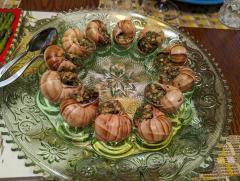 This is like
This is like 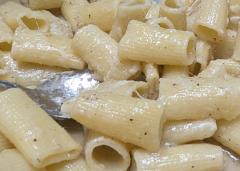 Cacio e Pepe (say KAHT-cho ay PEP-ay) is a traditional Roman dish of local pasta dressed with a wonderfully cheesy sauce that, like
Cacio e Pepe (say KAHT-cho ay PEP-ay) is a traditional Roman dish of local pasta dressed with a wonderfully cheesy sauce that, like